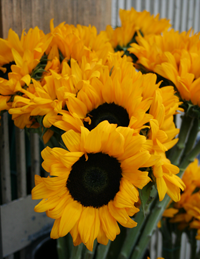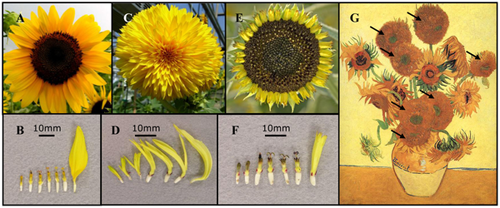Science and Art: Mutant Sunflowers
Variations in gene expression can lead to anomalies in flowers. Some of Van Gogh's sunflowers were of a mutant variety, and scientists recently tracked down genes that may be responsible.

When we think of a sunflower, many of us think of a bright yellow flower with a large, dark center, like the one shown above. In Van Gogh's famous serious of sunflower paintings, there are typical sunflowers intermixed with a few mutant ones. These mutant sunflowers posed a puzzle for plant scientists, but recent plant genetics research has uncovered the gene responsible.
Ask someone who Van Gogh was, and you are likely to hear one of two responses: he cut off his ear, or didn't he paint sunflowers? You might also catch an enlightened Starry Night over the Rhone reference, but, in truth, despite thousands of paintings, Van Gogh may be most well-known for his sunflower paintings, a series for which the most characteristic paintings were created in Arles, France in 1888 and 1889. Each painting in the intensely yellow and orange series expressively captures sunflowers in a vase and depicts flowers at various stages of the growth cycle. Though the number of sunflowers varies in the seven sunflower paintings from Arles, several of the paintings are very similar, only minute differences appearing between them.
A Scientific Conundrum
When I first spotted news stories (like this one from Nature) about the "mystery" of Van Gogh's sunflowers being scientifically resolved, I was surprised that there had been a "need" to solve a mystery about genetic ambiguity in a plant that appears in a painting, particularly in a painting from an expressionist painter. As an artist, not a scientist, I wanted to advocate appreciating and respecting the fact that a painter can, and often does, paint something that approximates reality but diverges from it. A painter may paint both what she sees and what she feels, and the combination of those realities, may yield something that doesn't exactly mirror reality. In other words, Van Gogh's painted sunflower doesn't have to look exactly like the sunflower he had in front of him. But, from the angle of science, if the flower Van Gogh painted looks like the one he had in front of him in 1888, the question of the flower's botanical evolution and history is intriguing because some of Van Gogh's flowers are not "typical" sunflowers.
Floral Symmetry
To make sense of what triggered the research—or the association with Van Gogh—I first had to get a better understanding of "why" the sunflowers in the paintings stand out as such anomalies to plant scientists. If you are of the "a sunflower is a sunflower" persuasion, you might look at one of Van Gogh's sunflower paintings and not see anything out of the ordinary. But a botanist immediately spots an interesting problem—not all of the flowers have the large dark center that is characteristic of a sunflower. Understanding the importance of this visual difference requires taking a step backward to look at the organization and symmetry of flowers in general—and the peculiar symmetry of sunflowers.
When it comes to symmetry, most flowers fall into one of two categories and demonstrate either radial symmetry or bilateral symmetry. In a flower with radial symmetry, you can rotate the flower, and the arrangement of petals continues to appear the same. This pattern is seen in "round"-faced flowers like water lilies and buttercups. Bilateral symmetry, on the other hand, occurs when the two sides of a flower (left and right of an imaginary middle line) mirror each other. An orchid is a classic floral example of bilateral symmetry, but it's easy to visualize this arrangement by thinking of the human face, which is symmetrical along a middle line that divides the nose in half. (Turn the face upside down, and you know the orientation is wrong!)
The interesting thing about a sunflower is that it contains both radial and bilateral symmetry. What appear to be "petals" in the outer ring are actually small flowers, or ray florets, which are bilaterally symmetrical. The dark inner ring, on the other hand, is a cluster of radially symmetrical disk florets. The florets in the center will be fertilized during the life-cycle of the flower, filling the center with seeds. So that's a classical sunflower: an outer ring of small infertile flowers surrounding a large center ring of florets that produce seeds. Now, look again at Van Gogh's sunflowers. Some of them, indeed, sport the familiar dark center. But others do not. The "other" flowers are referred to as double-flowered mutants and contain no center array of disk florets. (The opposite is also possible, mutants which contain only the dark disk florets.)
These mutant sunflowers sparked the research of Mark Chapman and colleagues at the University of Georgia. The team recently published results in PLoS Genetics titled "Genetic Analysis of Floral Symmetry in Van Gogh's Sunflowers Reveals Independent Recruitment of CYCLOIDEA Genes in the Asteraceae." The paper reveals their findings that Van Gogh's mutant flowers show a mis-expression of a CYCLOIDEA-like gene (HaCYC2c) responsible for symmetry in sunflowers. Over-expression of the same gene produces an opposite effect and yields tubular-rayed mutant sunflowers. According to Chapman and team's research, the gene responsible for Van Gogh's sunflowers and other "teddy bear" varieties that lack the dark center, appears to have evolved independently of similar genes in other members of the Asteraceae family (to which the sunflower belongs).

Image from the study published in PLoS Genetics.
"Entire inflorescences (A, C, E) and individual florets (B, D, F) from wildtype (A, B), double-flowered (C, D) and tubular (E, F) sunflower individuals. Florets are arranged left to right from the inner florets to the outer florets. (G) "Sunflowers (Still Life: Vase with Fifteen Sunflowers)" by Vincent van Gogh (1888) with double-flowered heads pointed out with arrows. Panel G was obtained from Steve Dorrington on flickr (available at http://flic.kr/p/8SsPYb) and is distributed under the terms of the Creative Commons Attribution 2.0 Generic (CC BY 2.0) License."
Making Connections
Students curious about the experimentation and research that enabled Chapman and his team to investigate questions about the development of these mutant sunflowers can learn more by delving into both the basics of genetics and the fundamentals of cross-breeding and hybridization in plant biology. As part of their study, the team reportedly cross-bred a number of varieties of sunflowers to track genes that might be responsible for double-flowering.
To begin understanding the ways in which the gene expression occurs, students can explore Mendelian traits in the "Pedigree Analysis: A Family Tree of Traits" Project Idea. This project deals with human characteristics, not plant biology, but the study offers an entry point for students to begin exploring principles of heredity and gene expression. Mendel's early research was on peas. Later research cross-breeding varieties of flowers furthered understanding of dominant and recessive genes.
Art and Science
Whether you approach Van Gogh's paintings as purely an observer or as a scientist or an expert in plant biology, you may never look at the sunflowers the same again. And the next time you drive by a local flower stand and see baskets of sunflowers, chances are you'll notice if there are any mutants in the crowd!
Categories:
You Might Also Enjoy These Related Posts:
- Plastics and Earth Day - Science Projects
- Arduino Science Projects and Physical Computing
- 10+ Robotics Projects with the BlueBot Kit
- 5 STEM Activities with Marshmallow Peeps
- March Madness Basketball Science Projects: Sports Science Experiments
- Women in STEM! More than 60 Scientists and Engineers for Women's History Month
- Explore Artificial Intelligence and Machine Learning with Student AI Projects
- 10 Reasons to Do the Rubber Band Car Engineering Challenge









